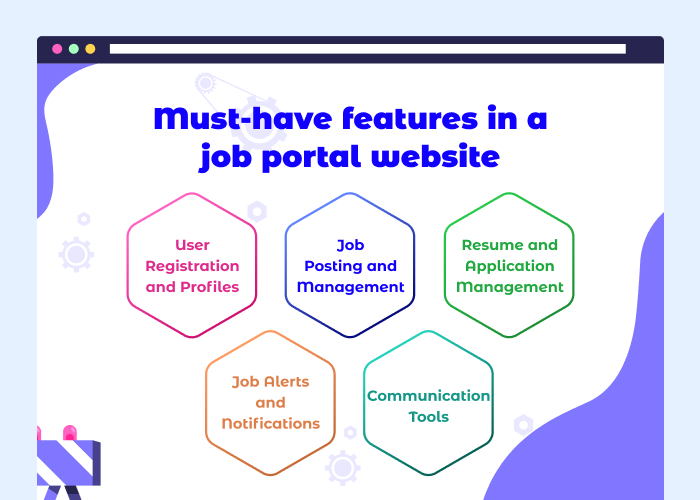Must-have features in a job portal website

The first step of how to build a job portal website like Indeed guide is listing out the features. Building a job portal website involves incorporating a range of features that cater to both job seekers and employers. These features enhance the UX, streamline the job search process, and improve the process of recruitment. Here are some must-have features for a successful job portal website:
- User Registration and Profiles: Enable job searchers to construct comprehensive profiles that contain personal data, cover letters, resumes, skills, and employment history. Furthermore, enable employers to create profiles to showcase their company details, culture, and job openings.
- Job Posting and Management: Job posting options should include comprehensive job descriptions, prerequisites, and application procedures posted by employers. Thus, employers may quickly maintain and amend their job advertisements using these tools.
- Resume and Application Management: Allow candidates to submit and save several copies of their cover letters and resumes. Furthermore, add tools that help companies manage applications received and job seekers keep track of their applications.
- Job Alerts and Notifications: This feature helps applicants for jobs set up email alerts to receive notifications when new positions meet their criteria. Furthermore, these alerts help employers know the latest received applications.
- Communication Tools: An internal messaging system for communication between job seekers and employers must be added. Furthermore, integrate tools to schedule and manage interviews directly through the platform.
Thus, this How to Build a Job Portal Website guide will help you integrate essential features and provide a comprehensive platform for both job seekers and employers. Therefore, it ultimately facilitates better job matches and a smoother recruitment process.
How to build a job portal website and what are the steps?
Building a job portal website involves a series of well-defined steps, from initial planning to deployment and maintenance. Here’s a detailed guide to help you through the process:
- Identify Target Audience: Understand the needs of job seekers and employers. Furthermore, study existing job portals to identify their strengths and weaknesses. Determine what will set your job portal apart.
- Requirement Gathering: Compile a list of must-have and nice-to-have features. Decide on the technology stack, platform (web, mobile), and any third-party integrations. Lastly, establish a budget and a realistic timeline for development.
- UI/UX design: Create basic sketches or wireframes of your website’s layout. Design the user interface, focusing on ease of use and accessibility. Develop a clickable prototype to visualize the user flow and interactions.
- Development: Code the user-facing parts of the website using HTML, CSS, and JavaScript. Develop the server-side logic using languages like Python, Ruby, PHP, or JavaScript. Develop or integrate APIs for functionalities like job search, notifications, and third-party services.
- CMS: Decide whether to use a CMS like WordPress or build a custom CMS for managing job postings and content.
- Testing: Ensure all features work as intended. Test the user experience with real users and gather feedback. Check the website’s performance under various loads. Ensure the website is secure against common threats.
- Deployment: Select a reliable hosting service based on your expected traffic and technical requirements. Thereafter, register a domain name and configure your hosting environment. Upload the website to the hosting server and perform final checks.
- Maintenance and Updates: Regularly check the website’s performance and user feedback. Furthermore, continuously fix bugs and update the website with new features based on user needs and market trends.
How to build a job portal website at a low cost?
There are a few ways you can build a job portal website at a low cost. Two of the proven ways are mentioned below.
- Develop an MVP: Creating an MVP allows you to launch with only the essential features, minimizing initial costs while providing a functional product. This approach helps you validate your idea and gather user feedback for future improvements.
- Hire a web development company from India: Another answer to how to build a job portal website at a low cost is outsourcing your project to a web development company in India. It can be a cost-effective way to build a fully functional job portal website. Indian developers are known for their quality work at competitive prices.
Conclusion
In conclusion How to build a job portal website like Indeed, you need to plan carefully. Whether you choose to develop an MVP or outsource to a web development company from India, focusing on essential features and maintaining a user-centric design will help you create a platform that meets the needs of both job seekers and employers.
By following the steps outlined in this guide, you can develop a robust, efficient, and budget-friendly job portal website that streamlines the job search and recruitment process, ultimately fostering better job matches and enhancing the user experience.
FAQs
What are the essential features of a job portal website?
How can I build a job portal website at a low cost?
Why is developing an MVP beneficial?
How do I choose the right web development company in India?
What should I consider when choosing a CMS for my job portal website?
Ravi Bhojani is the Chief Marketing Officer (CMO) at Alian Software, where he spearheads the company’s marketing strategies and drives its brand presence in the competitive IT services landscape. With over a decade of experience in the technology and marketing sectors, Ravi has consistently demonstrated his ability to blend innovative marketing techniques with deep industry knowledge to deliver outstanding results.